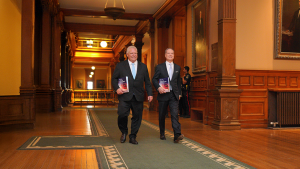Alberta’s 2022 budget has arrived and many in the province’s construction sector were pleased to see spending on capital projects and workforce development.
“Through new funding commitments to capital projects and steps to address the looming skill shortage crisis, we remain hopeful of the direction taken in the budget,” wrote the Calgary Construction Association (CCA) in a statement.
Some of the new capital project spending the CCA highlighted included:
- $41 million for SAIT’s John Ware Building redevelopment project.
- $38 million to replace the existing office of the chief medical examiner in Calgary.
- $97 million for new facilities across Alberta, including the Repsol Sports Centre, the Calgary Stampede Foundation SAM Centre and the Canmore Nordic Centre.
- $744 million in total and $474 million over the next three years for the Springbank off-stream reservoir flood mitigation project.
- $22.3 million over the next three years towards the construction of a new interchange on the Northeast Stoney Trail and Airport Trail.
The association also noted the budget includes $30 million over three years to expand apprenticeship education and $6 million over three years to fund 1,200 new work-integrated learning opportunities.
“The looming skill shortage is one of the biggest challenges facing the construction industry and its effects are being felt already,” said the CCA. “Baby Boomers with over 40 years of work experience are retiring, and Generation X and Millennials are seeking to step up in their roles. Greater emphasis needs to be made on attracting and retaining skilled workers to fill the looming labour gaps in the local industry.”
The Alberta Construction Association (ACA) also expressed approval for the budget, noting increased expenditures by $900 million in 2022-23 and $450 million in 2023-2024 compared to the 2021 budget.
“ACA also applauds the government’s commitment to significantly increase funds to support Albertans to improve skills and successfully gain employment – more than $600 million over the next three years,” said the group. “Alberta’s construction industry has numerous opportunities for rewarding careers to replace more than 24,000 expected retirees over the next decade.”
The association added the province’s level of investment needs to keep pace with population growth and inflation.
“Construction is one of Alberta’s largest employers, directly accounting for approximately 228,000 jobs or one in 10 working Albertans, with thousands of additional jobs in related occupations. Jobs are a priority and keeping Albertans employed in good paying jobs is critical to the economic engine.”
The Alberta Roadbuilders and Heavy Construction Association (ARHCA) was pleasantly surprised by the budget.
“Generally speaking, this budget was much better than what we would have expected even four months ago,” said Ron Glen, ARHCA CEO. “The dramatic turnaround in oil prices, natural gas prices and the increased demand swung the provincial revenue picture tremendously.”
The association had been bracing for a significant deficit budget, but the province now sees budget surpluses on the horizon.
“This is a massive turnaround because of the change in oil prices and change in demand but also the economy is generally turning the corner and coming back,” said Glen. “After five long years of recession and economic downturn we are finally turning the corner, so overall this was good news for Alberta. What could have been cutbacks to capital programs ended up being small increases from last year.”
However, Glen worries inflation could gobble up some of the gains. The industry still faces supply chain disruptions that have caused material prizes to fluctuate and delayed the delivery of critical equipment. The other side of the coin on oil prices means projects will have to spend more on fuel.
Despite these challenges, Glen feels the province has been responsive to industry needs.
“They heard us that continued underinvestment in road investment just costs more in the long term and it makes for more expensive repairs,” said Glen. “I think they have addressed that, putting money into rehab and maintenance projects – maybe not enough but they are doing what they can. We have to look at longer term solutions to this and will be proposing some different ways of managing that in the future, but overall, they did a good job, particularly when you look at where we could have been.”
Follow the author on Twitter @RussellReports.











Recent Comments
comments for this post are closed